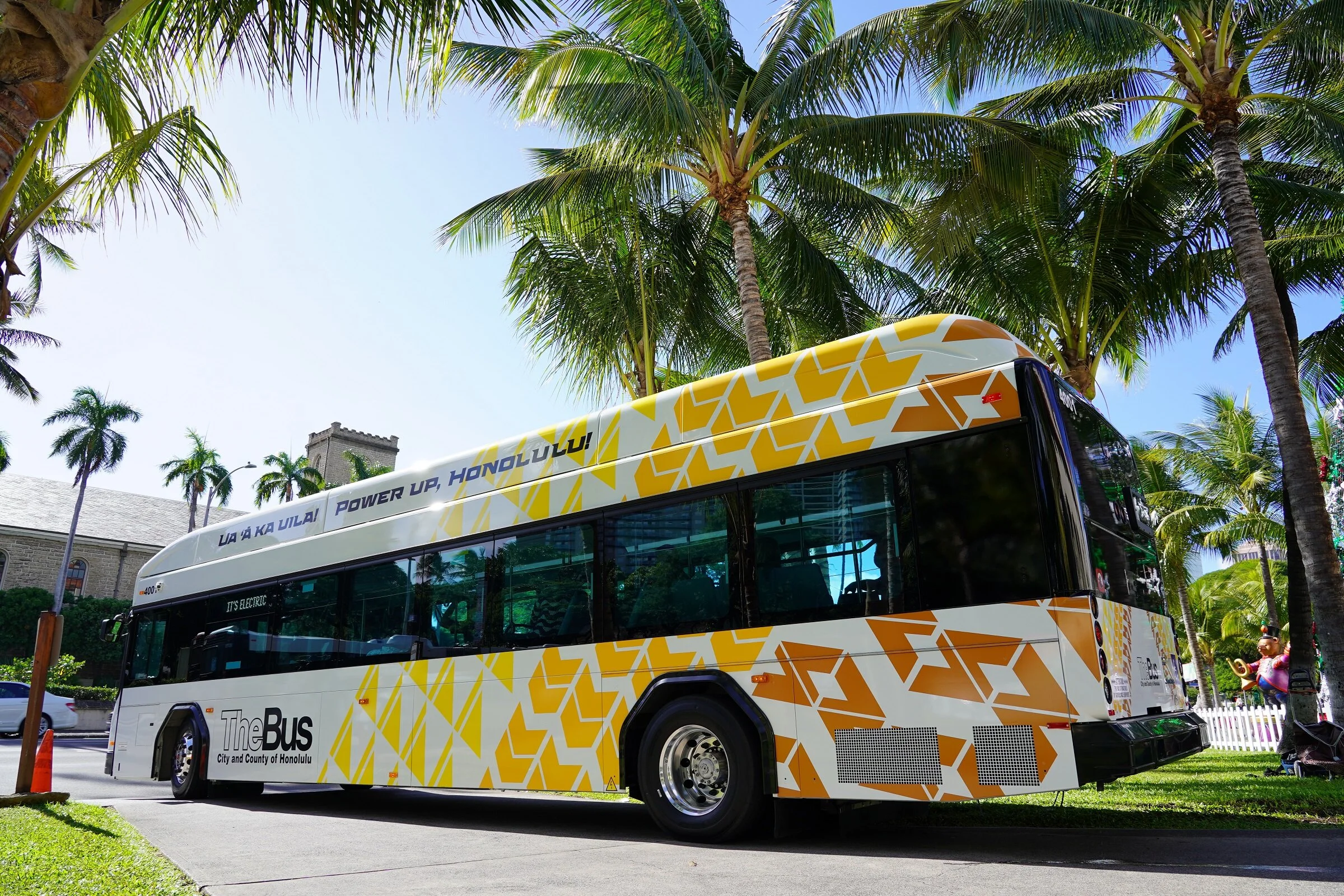
Climate Action Plan at a Glance
Ground Transportation
Ground transportation — cars, trucks, motorcycles, buses, and other heavy-duty vehicles — account for 19% of O‘ahu’s greenhouse gas emissions. This trend has remained flat over the last decade, so more must be done to bend the curve.
Enabling safer, more affordable, and convenient transportation options for residents to take transit, bike, walk, or carpool can both reduce emissions and improve overall quality of life on O‘ahu. Focusing growth and greater housing affordability in areas near transit can help reduce the need for car trips and protect natural lands and open space. Additionally, the City has already committed to fully transforming its own vehicle fleet to electric or renewable technology by 2035, and is supporting the transition to electric vehicles island-wide. The following four high-impact strategies will further reduce emissions from O‘ahu’s ground transportation sector.
▿Strategy 1: Encourage Density and Mixed Land Use in Strategic Areas
Action 1.1: Continue to adopt policies that support greater housing affordability located near transit and in areas in proximity to job centers and key destinations.
Action 1.2: Continue revising the City’s land use and zoning regulations to allow for mixed-use development across O‘ahu to support “complete communities.”
Action 1.3: Work with private sector to provide connectivity and streetscape infrastructure in new developments to support complete streets principles.
▿Strategy 2: Enable and Provide Multiple Modes of Green Transportation
Action 2.1: Implement the O'ahu Bike Plan and continue to build out protected bikeways for all ages and abilities with safe connections between existing bike lanes.
Action 2.2: Develop a City-focused Transportation Demand Management (TDM) program, and consider updating the telework policy.
Action 2.3: Complete the O‘ahu Pedestrian Plan and implement high priority pedestrian projects.
Action 2.4: Plant trees as part of roadway rehabilitation projects to provide shade for pedestrian, bicycle, and transit infrastructure and promote comfort for frequent trips.
Action 2.5: Repurpose general travel and parking lanes for multimodal and active transportation use.
Action 2.6: Increase non-vehicular mode share in new multi-family housing and commercial developments through TDM programs.
Action 2.7: Identify candidate projects and develop dedicated bus lanes along high-occupancy transit corridors.
Action 2.8: Launch integrated transit fare card (Holo) to include a fare-capping program for relevant daily, monthly, and annual rates.
Action 2.9: Hire a Mobility Manager to leverage opportunities to increase micromobility services.
Action 2.10: Create a universal trip planning and fare app to improve the connectivity of multimodal transportation options.
Action 2.11: Seek innovative business solutions to deliver vehicle miles traveled (VMT) reduction services.
▿Strategy 3: Encourage Mode Shift through Parking Efficiency
Action 3.1: Allow for flexibility in the provision of parking by eliminating current minimum off-street requirements.
Action 3.2: Encourage unbundling the sale or rent of multi-dwelling housing units from parking in transit-oriented developments (TOD) and other suitable neighborhoods.
Action 3.3: Develop curb management systems within TOD and other high-demand areas.
Action 3.4 Efficiently manage and price public parking at City-owned lots and parking spaces with high transportation alternatives and implement dynamic metering rates.
Action 3.5: Repurpose underutilized public parking in preference to multimodal transportation infrastructure, urban greenery, and public-serving spaces.
▿Strategy 4: Electrify the City Fleet and Support High Efficiency Vehicles
Action 4.1: Develop and adopt an electric bus purchasing policy for the City’s bus fleet to reach 100% renewable powered City fleet goal by 2035.
Action 4.2: Develop a plan and implement City passenger vehicle fleet transition to achieve 100% clean fleet goal by 2035.
Action 4.3: Develop, for EV buses and other City-owned EVs, charging protocols such that it facilitates integration of intermittent renewable energy.
Action 4.4 Expand EV charging infrastructure for the City EV fleet by tripling public charging capacity on City facilities; enable electricity costs recovery.
Action 4.5: Provide private car sharing with high fuel efficiency vehicles priority access parking to enable point-to-point service in high usage areas.

